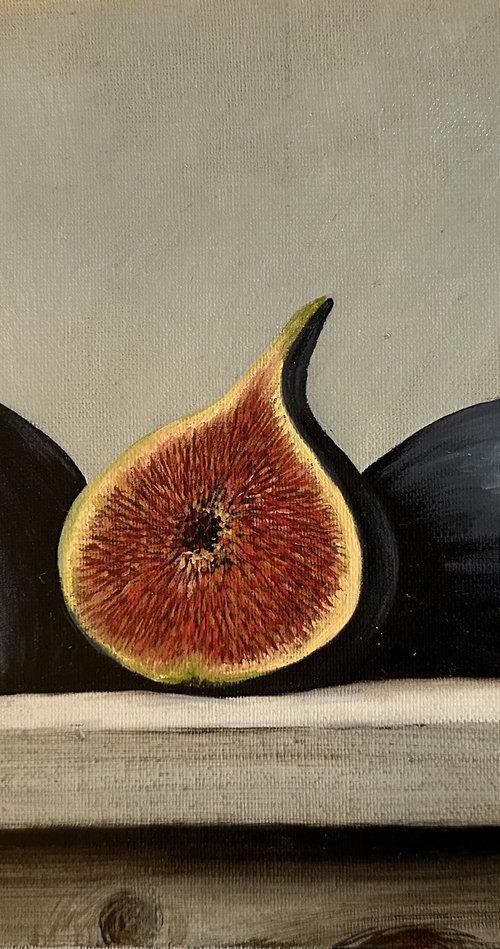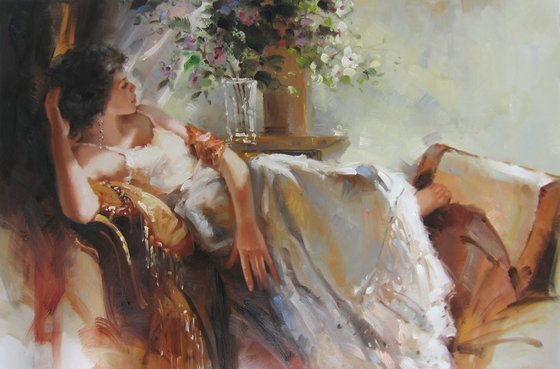Beautiful Handcrafted Oil Paintings for Sale from Workshops
Wiki Article
Discovering Everything About Oil Paints: A Guide to Understanding Their Appeal and Worth
Oil paintings have mesmerized audiences for centuries, supplying a peek into the creative proficiency of different periods. Their rich background is intertwined with cutting-edge techniques and extensive emotional expression. Recognizing the materials and techniques behind these art work can improve gratitude. In addition, the marketplace for oil paintings presents chances for enthusiasts and financiers alike. As one explores this interesting globe, the inquiry arises: what makes an oil painting really useful?The History of Oil Painting: A Trip Through Time
Although oil paint has roots that go back to ancient times, it really flourished throughout the Renaissance, when artists uncovered its convenience and rich color potential. Early instances can be mapped to the 7th century, with methods evolving significantly across cultures. The medium came to be noticeable in Northern Europe in the 15th century, especially via the works of artists like Jan van Eyck, who originated its use for thorough realistic look and vivid hues. This duration marked a departure from tempera paints, enabling higher deepness and appearance. As oil painting spread, it influenced many artists, bring about masterpieces by distinguished figures such as Leonardo da Vinci and Rembrandt. The medium's heritage continues, shaping the art globe well right into modern times.Recognizing Oil Paints: Products and Techniques
As artists discover the globe of oil paints, they experience a varied array of products and techniques that define this tool. The key elements of oil paint include pigments, which offer shade, and drying out oils, such as linseed, that bind the pigments and facilitate application. Numerous additives can change the paint's texture and drying out time, boosting flexibility. Techniques like glazing, where clear layers are accumulated, and impasto, which involves applying thick paint, enable different aesthetic impacts. In addition, using brushes, scheme knives, and also fingers can create distinct structures and finishes. Recognizing these products and strategies allows artists to completely express their imagination and achieve the desired impact in their artwork.The Role of Shade in Oil Paints
Shade plays a pivotal function in oil paintings, influencing both visual allure and psychological resonance. Understanding shade concept fundamentals, consisting of the partnerships between hues, can improve an artist's capacity to share mood and atmosphere. In addition, mastering shade blending techniques enables better depth and splendor in a paint's palette.

Shade Concept Fundamentals
Recognizing shade concept is essential for musicians functioning with oil paints, as it creates the structure for producing unified and aesthetically appealing structures. Shade theory encompasses the study of exactly how shades communicate, the color wheel, and the relationships in between main, secondary, and tertiary colors. Musicians use complementary shades to improve contrasts and create centerpieces, while similar colors advertise unity and cohesiveness within an item. Additionally, the concepts of trendy and cozy colors affect the perception of depth and room in a painting. Grasping these concepts permits artists to adjust color efficiently, leading the audience's eye and communicating their desired message. Mastery of color concept inevitably improves an artist's capacity to communicate emotions and ideas via their work.
Psychological Impact of Color
The psychological impact of shade in oil paintings plays an important function in just how audiences attach and regard with artwork. Shades evoke details feelings and state of minds, influencing the customer's emotional state. Cozy tones like oranges and reds can create a feeling of heat and power, while cool tones such as blues and eco-friendlies usually evoke peace or self-questioning. Artists purposefully pick shade schemes to enhance narrative elements, guiding the target market's psychological journey. The saturation and comparison of shades further magnify these results, attracting attention and creating emphasis. Ultimately, the interaction of shades in oil paintings not only enhances their aesthetic appeal but likewise functions as an effective tool for psychological expression, enhancing the viewer's experience and analysis.Color Mixing Techniques
While numerous aspects of oil paint add to the general composition, mastering color blending techniques is essential for attaining preferred impacts and depth. Shade blending can be approached through various methods, consisting of the subtractive and additive processes. Additive mixing includes combining shades of light, while subtractive blending counts on pigments, where shades mix to develop brand-new shades. Artists commonly make use of a minimal palette to develop harmonious works, recognizing the connections between key, additional, and tertiary colors. Strategies such as glazing and scumbling even more enhance deepness and luminosity. By masterfully mixing shades, an artist can stimulate feelings, produce prime focus, and attain a sense of realistic look, ultimately boosting the painting's visual and emotional effect.Famous Oil Painters and Their Iconic Functions

Renowned for their mastery of shade and technique, oil painters have actually created a few of one of the most well known art work in background. Popular musicians like Vincent van Gogh captivated audiences with his stirring brushwork in "Starry Night," while Claude Monet's "Perception, Sunup" laid the groundwork for Impressionism. Leonardo da Vinci's "Mona Lisa" stays a long-lasting symbol of creative wizard, showcasing his skill in catching human expression. At the same time, Rembrandt's "The Evening Watch" highlights his ingenious use light and darkness. Various other noteworthy figures consist of Pablo Picasso, that reinvented modern art with his bold testing in jobs like "Les Demoiselles d'Avignon," and Georgia O'Keeffe, whose vivid representations of landscapes and flowers helped define American modernism. Each artist's distinct style contributed substantially to the oil painting landscape.
Exactly how to Assess the High Quality of an Oil Painting
Examining the high quality of an oil painting entails a mindful analysis of website workmanship techniques, as well as an evaluation of shade and composition. Observing brushwork, layering, and the application of paint can disclose the musician's skill degree. Furthermore, the interplay of shades and the general arrangement of components contribute significantly to the painting's visual value.Evaluating Craftsmanship Methods
A careful evaluation of workmanship methods is crucial for establishing the top quality of an oil painting. Critics must initially take a look at the application of paint; thick, textured brushstrokes might recommend a competent hand, while excessively uniform applications could suggest an absence of deepness. oil paintings for sale. The layering strategy is likewise important; the presence of glazes and differed thickness can enhance brightness and intricacy. Furthermore, the high quality of the products made use of, such as the canvas and pigments, plays a considerable function in longevity and general visual. Attention to information in aspects like sides and changes in between colors mirrors the musician's commitment to their craft. Ultimately, these techniques add to the paint's emotional effect and market price, functioning as indicators of the musician's skill and intentAnalyzing Shade and Composition
While examining the quality of an oil paint, one should concentrate on the interplay of shade and composition, as these aspects are fundamental to the artwork's overall influence. Color options can stimulate feelings and establish state of mind; for that reason, the artist's palette need to be taken a look at for consistency and comparison. A well-balanced structure guides the visitor's eye and develops a feeling of unity. Musicians often employ strategies like the policy of thirds or leading lines to enhance aesthetic passion. Additionally, the usage of light and darkness can include depth, improving the three-dimensionality of the paint. Inevitably, a successful oil painting marries color and composition, engaging the viewer and welcoming a much deeper admiration of the musician's vision and method.Caring for and Preserving Oil Paintings
Appropriate care and preservation of oil paints is crucial for maintaining their stability and durability. To shield these art work, it is vital to display them away from straight sunlight, which can cause fading and staining. Keeping a secure setting with regulated temperature level and humidity further help in preventing damages. Cleaning up ought to be done gently using a soft, completely dry fabric, preventing any rough chemicals that could damage the paint or varnish. Normal examinations for indicators of deterioration, such as splitting or flaking, are suggested. When transferring or keeping oil paintings, correct cushioning and framing are needed to prevent physical injury. Eventually, diligent treatment adds to the visual charm and value of oil paints gradually.The Market for Oil Paints: Collecting and Spending
Understanding the marketplace dynamics for oil paints is important for financiers and collectors alike. The worth of these art work is influenced by various factors, consisting of the artist's reputation, historical significance, and existing patterns. Collectors usually seek items that reverberate personally while taking into consideration prospective gratitude in worth. Galleries and auctions work as main places for buying and selling, with costs rising and fall based on demand and rarity. Investing in oil paints needs study right into the market, as well as an understanding of authenticity and provenance. Furthermore, emerging artists may use chances for substantial returns, while established names can command high prices. On the whole, a calculated approach to gathering can generate both aesthetic enjoyment and monetary rewards.
Often Asked Concerns
What Are the Ecological Effects of Oil Painting Products?
The environmental influences of oil paint materials consist of the launch of unstable natural compounds (VOCs), hazardous waste generation, and resource removal for pigments. These elements add to pollution and environmental destruction, increasing problems amongst environmentally conscious artists and customers.How Do Different Canvases Affect Oil Painting Results?
Different canvases influence oil paint results considerably. Absorbency, texture, and surface top quality can modify paint application, drying out times, and shade vibrancy. Artists often choose specific canvases to achieve wanted results and boost their creative expression.Can Oil Paintings Be Brought Back if Damaged?
Oil paintings can certainly be restored if damaged. Specialist conservators utilize different methods to repair tears, tidy surface areas, and address staining, making sure that the artwork retains its initial elegance and worth for future generations.What Are the Indications of an Original Oil Painting?
The signs of an original oil painting consist of visible brush strokes, texture variants, and an unequal canvas weave (oil paintings for sale). In addition, authenticity might be verified through provenance, signatures, and the presence of a varnish layer special to oil toolsExactly How Has Innovation Influenced Modern Oil Paint Techniques?
Technology has actually considerably affected modern oil painting techniques by presenting electronic devices for preparation, enhanced products for appearance and durability, and on the internet systems for sharing and marketing art, thus broadening musicians' innovative possibilities and target market get to. Oil paint has roots that date back to ancient times, it truly grew throughout the Renaissance, when artists discovered its flexibility and rich color possibility. The psychological effect of color in oil paintings plays a critical duty in just how audiences attach and regard with art work. While several elements of oil painting add to the total structure, mastering color blending techniques is important for achieving wanted impacts and deepness. Examining the top quality of an oil paint involves a cautious assessment of craftsmanship methods, as well as an analysis of color and make-up. While examining the quality of an oil paint, one need to focus on the interplay of shade and structure, as these components are basic to the art work's overall impact.Report this wiki page